Ceramic Tile
Cost-effective and solid, ceramic tile flooring comes in a variety of colours and styles, allowing you to pick a design that suits your home’s aesthetic.
Porcelain is a specific type of ceramic tile, and has a particularly low absorption rate, meaning that it’s almost entirely waterproof. The tiles are easy to clean and don’t stain, but the grout can, so it’s still important to clean up spillages quickly.
Another drawback of ceramic tiles is how cold and slippery they can be. Opting for a textured finish and including underfloor heating would reduce these risks.
Wood
If you’re set on a wood-finish flooring, there are two options depending on the room you’re planning to decorate:
For kitchens, you’ll want to go for hardwood. This is durable and water-resistant, but can be slippery – opting for a textured finish will resolve this issue.
There’s a variety of colours and textures available, and wood can be laid in different patterns dependant on your preference. For the environmentally conscious, there’s the option for reclaimed, recycled, and sustainable hardwood.
For bathrooms on the other hand, engineered wood is the most appropriate material. This has a plywood base and is finished with a wooden veneer on top, meaning that it really looks like real wood.
It stands up to moisture far better than hardwood, offering the waterproofing required for bathroom environments. Unfortunately, this material can be expensive.
Natural Stone
There are a variety of natural stone flooring options, but the most common are marble, granite, and limestone. These are stunning to look at, especially when used in large spaces, but can suit smaller rooms too.
They are also extremely durable, however natural stone is expensive and can be difficult to install. It can also be slippery if you don’t opt for a textured surface.
Laminate
This material is warm and water-resistant, and offers a cost-effective alternative to hardwood whilst still looking good. Whilst laminate is not traditionally waterproof, there are some new versions on the market that offer this feature, but this of course comes at an extra cost.
You should also be aware that regardless of how water-resistant or waterproof this material is said to be, it’s woodchip-based underneath. If this part comes into contact with water, it will expand; this damage is irreparable and the whole floor would need to be pulled up. It is however relatively easy to install and can be cleaned easily.
Vinyl
Vinyl flooring has been a popular choice for decades and isn’t going anywhere any time soon! It’s extremely durable and very practical. It boasts the perks of simple installation/removal, being easy to clean, and cost-effective. Vinyl is also 100% waterproof, making it a great flooring choice for your bathroom or kitchen.
However, if your floor surface is uneven, any lumps and bumps are likely to show through vinyl. There are a variety of style options available though, so you may be able to counteract this by choosing a textured or patterned material.







